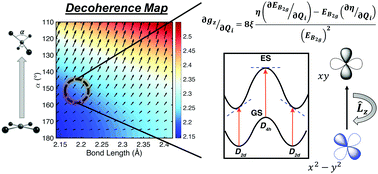The dynamic ligand field of a molecular qubit: decoherence through spin–phonon coupling†
Abstract
Quantum coherence of S = 1/2 transition metal-based quantum bits (qubits) is strongly influenced by the magnitude of spin–phonon coupling. While this coupling is recognized as deriving from dynamic distortions about the first coordination sphere of the metal, a general model for understanding and quantifying ligand field contributions has not been established. Here we derive a general ligand field theory model to describe and quantify the nature of spin–phonon coupling terms in S = 1/2 transition metal complexes. We show that the coupling term for a given vibrational mode is governed by: (1) the magnitude of the metal-based spin–orbit coupling constant, (2) the magnitude and gradient in the ligand field excited state energy, which determines the magnitude of ground state orbital angular momentum, and (3) dynamic relativistic nephelauxetic contributions reflecting the magnitude and gradient in the covalency of the ligand–metal bonds. From an extensive series of density functional theory (DFT) and time-dependent DFT (TDDFT) calculations calibrated to a range of experimental data, spin–phonon coupling terms describing minimalistic D4h/D2d [CuCl4]2− and C4v [VOCl4]2− complexes translate to and correlate with experimental quantum coherence properties observed for Cu(II)- and V(IV)-based molecular qubits with different ligand sets, geometries, and coordination numbers. While providing a fundamental framework and means to benchmark current qubits, the model and methodology described herein can be used to screen any S = 1/2 molecular qubit candidate and guide the discovery of room temperature coherent materials for quantum information processing.

- This article is part of the themed collection: 2020 PCCP HOT Articles


 Please wait while we load your content...
Please wait while we load your content...